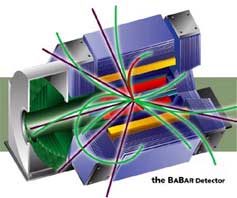
Handy Links
SLAC News Center
SLAC Today
- Subscribe
- Archives: Feb 2006-May 20, 2011
- Archives: May 23, 2011 and later
- Submit Feedback or Story Ideas
- About SLAC Today
SLAC News
Lab News
- Interactions
- Lightsources.org
- ILC NewsLine
- Int'l Science Grid This Week
- Fermilab Today
- Berkeley Lab News
- @brookhaven TODAY
- DOE Pulse
- CERN Courier
- DESY inForm
- US / LHC
SLAC Links
- Emergency
- Safety
- Policy Repository
- Site Entry Form

- Site Maps
- M & O Review
- Computing Status & Calendar
- SLAC Colloquium
- SLACspeak
- SLACspace
- SLAC Logo
- Café Menu
- Flea Market
- Web E-mail
- Marguerite Shuttle
- Discount Commuter Passes
-
Award Reporting Form
- SPIRES
- SciDoc
- Activity Groups
- Library
Stanford
Around the Bay
Bs Take an Early Break
 The fifth BaBar data taking run came to a close late last night when a small cable fire broke out in Interaction Region 4. The fire started as an experiment aimed at future improvements to the accelerator neared its end, damaging cables in a limited area of the PEP-II ring well away from the BaBar detector, which is located in Interaction Region 2. No one was hurt and all emergency equipment worked properly, containing the fire quickly.
The fifth BaBar data taking run came to a close late last night when a small cable fire broke out in Interaction Region 4. The fire started as an experiment aimed at future improvements to the accelerator neared its end, damaging cables in a limited area of the PEP-II ring well away from the BaBar detector, which is located in Interaction Region 2. No one was hurt and all emergency equipment worked properly, containing the fire quickly.
The root cause of the fire is not yet clear, but it most likely started near a fan installed to cool a kicker, a component used by the accelerator feedback systems to control the beams. Such a fire is the first of its kind for PEP-II.
Investigations into the root cause of the fire will continue today and possibly into the weekend.
The shutdown was scheduled to begin Monday morning with a full program of updates and modifications on PEP-II and BaBar. Over the course of the four-month shut down, the BaBar detector and the PEP-II rings are scheduled to see major improvements, along with routine maintenance and safety checks.
"The key to our future will be upgrading the machine to operate with a higher luminosity," said BaBar Spokesperson David MacFarlane. "Although Run 5 has been enormously successful, BaBar is always hungry for more data and we eagerly anticipate the coming improvements."
The PEP-II team has already brought the machine's luminosity to incredible heights, four times what the machine was designed for. But more luminosity means more collisions that produce the exciting results BaBar is after. The goal of the upgrades is to nearly double the current peak luminosity over the next two years, resulting in a doubling of the number of available B-anti-B events as well.
PEP-II has a long-list of planned improvements. New radio-frequency accelerating cavities to allow for even higher beam currents, many new vacuum chambers near the BaBar detector, and replacement beam-position instrumentation throughout the low-energy ring will all be installed over the down.
On the BaBar side, the major project is completing the upgrade of the muon detection system, which will significantly improve the experiment's ability to efficiently identify muons and reject background events. The first third of the new system was already installed during the 2004 shut down. "Preparations for completing the muon system upgrade have been underway for more than a year. We see a very busy 4 months ahead," said BaBar Technical Coordinator Bill Wisniewski.
"The muon upgrade will improve our sensitivity to some rare decays where new physics could show its hand," said Jim Olsen, incoming physics analysis coordinator for BaBar.
Although data taking stops, BaBar researchers will be hard at work analyzing the new data, with a flood of new results from Run 5 still to come.
—Heather Rock Woods and Kelen Tuttle
SLAC Today, August 18, 2006